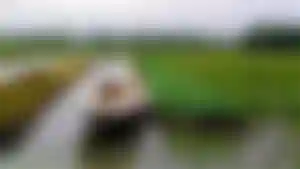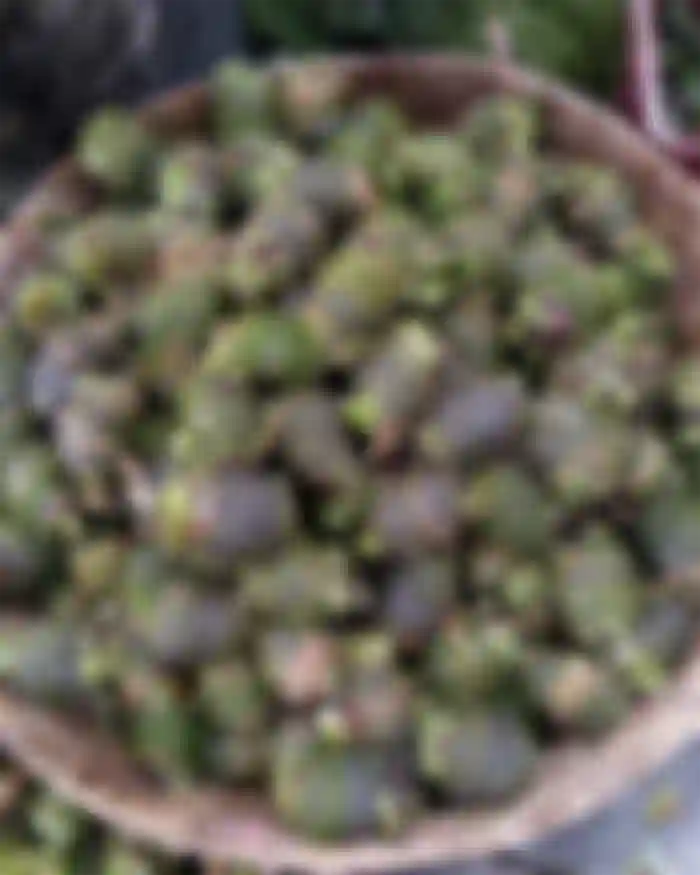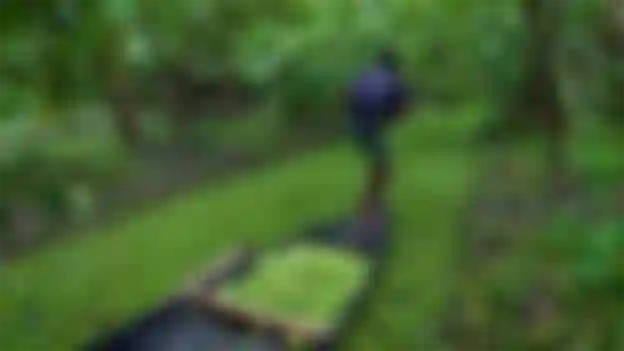Ripening squash, bitter gourd and okra loom over a mass of water hyacinth. Birds fly low over the surface of the water. Bijoy Kumar, a farmer in the low-lying Gopalganj district of Bangladesh, stands knee deep in water, tending to his plants. He and his family could not escape the rising waters in the volatile monsoons – so they abandoned the traditional rice crop. He turned instead to an eco-friendly practice that had been used by his ancestors in the southern flood plains, a traditional form of hydroponics, called floating vegetable gardens.
Bangladesh, by the fact it was formed by the alluvial plains of the Ganges-Brahmaputra river systems, is prone to floods and waterlogging. Fierce monsoons, Himalayan snow melt and severe cyclones exacerbate the problem for the country. Two-thirds of Bangladesh is wetland, criss-crossed by highly sedimented rivers that frequently change their course. Vast swathes of land in the country are under water for as much as eight months in a year, while seawater intrusion also makes much coastal land useless for growing crops.
And yet agriculture is one of the most important contributors to the country’s GDP. Bangladesh is also one of the world’s poorest countries, where 48% of the 160-million-strong population is landless. The number of people displaced from their homes in Bangladesh because of climate change is predicted to rise to one in seven of the population by 2050. Some farmers are giving up agriculture and looking for alternative ways to make a living, while others find work at clothing factories or moving to farm shrimp.

As sea levels rise, a historic agricultural practice is offering respite to farmers who are losing their land (Credit: Fahmida Akter)
But in one part of south-central Bangladesh, for 300-400 years, people have been following an age-old traditional method of cultivation called dhap, or known locally as baira. These are floating vegetable gardens – artificial islands, that simply rise and fall with the swelling waters. Now farmers are reviving this old practice to reduce their vulnerability due to climate change.
Floating gardens are most common in the districts of Gopalganj, Barisal and Pirojpur. Here, during monsoons the farmers gather weeds like water hyacinth or paddy stalks, and place them on stagnant water, beating them into shape and making rafts. They plant seedlings on these organic beds, and place them in flooded parts of the villages.
Kumar and his family collected water hyacinth, building a rectangular raft out of it, and planted it with vegetable seedlings. The buoyancy of this floating garden allows it to rise with the water levels. “This has made a great difference to my life. Now I have enough food in the floods, and I can give some to help my neighbours and relatives as well,” he says.
This kind of soil-free cultivation also exists in different parts of the world, such as Dal Lake in Kashmir and Inle Lake in Myanmar, where people have adapted to living on the water. The UN’s Food and Agricultural Organization declared Bangladesh’s floating gardens to be a globally important agricultural heritage system in December 2015. These are landscapes that combine agricultural biodiversity, resilient ecosystems and cultural heritage.

Water hyacinth is an invasive weed in parts of Bangladesh, but now it is being used to form soil-free beds for the country's floating gardens (Credit: Getty Images)
Dhaka-based Haseeb Irfanullah, an independent environment and climate change consultant, and former program coordinator at the International Union for Conservation of Nature (IUCN), says that his friends who lived in villages have grown up seeing their mothers and grandmothers make floating gardens. “It was something as common as having a small terrace garden in a city,” he says.
Anatomy of a floating garden
Farmers stack several compact layers of aquatic weeds like water hyacinth, duckweed or paddy stubs – the stubble of what remains after the rice grain has been harvested. They are helped usually by their families and neighbours. The weeds are allowed to rot, and then mixed usually with cow dung and silt. Crop seeds are placed in small balls called tema that are made out of peat soil, and wrapped in coconut fibre.
After a week, when seedlings are about 15cm high, they are transplanted to the floating garden beds. Traditionally, seeds of leafy vegetables, like red amaranth, are sown directly on the floating beds. They are then anchored with bamboo poles, so that they don’t drift away.
Both men and women work to make these organic floating beds, which last for around five to six months. Farmers grow vegetables like okra, bitter gourd, snake gourd, spinach and brinjal on these beds, and sometimes spices like turmeric and ginger. Besides vegetables, rice seedlings can sometimes be grown. During the monsoon, farmers use small boats to navigate between these small islands.

Agriculture has to adapt to watery conditions, whether that is through floating vegetable gardens, or farming on raised beds – as in the sorjans of Pirojpur (Credit: Getty Images)
A typical floating bed is about 20ft (6m) long, but they can be as long as 180ft (55m) and provides enough food for the farmer and their family, and a source of income when the surplus is sold. People are experimenting with the materials used to create the floating gardens – sometimes they use rice and wheat stalks, occasionally adding a system of inner tubes made from car tires and a bamboo framework for additional support.
“Still water protected from waves and tides in canals, rivers and lagoons are the best places for these floating gardens,” says Irfanullah. “It’s great division of labour, with the women preparing the delicate seedling balls, and the men making the beds and planting them.” Most of the organic beds don’t need any fertilisers, as the plants can absorb nutrients like nitrogen, potassium and phosphorus from the organic matter in the beds and the water below.
Their low cost makes the gardens a realistic option for many farmers, says Nazmul Islam Choudhary of the international agency Practical Action. The average cost of a floating bed is around 8,000 Bangladeshi taka ($94/£73), making food production possible throughout the year and providing food security even during the monsoons. According to a FAO report, the farmers earn an average profit of $140 per 100 square metres (£107/1,070 sq ft) of floating bed during the monsoon season.
Hamida Bai, a farmer in the Barisal district, is a proud owner of 10 floating beds. “These floating gardens are more productive than terrestrial gardens,” said Bai. “Since there is no soil, plant diseases and weeds are rare.”
Many floating farms double up as places where poultry and cattle can also shelter in the monsoons, and where people can fish. “Another advantage of these gardens is that invasive species like water hyacinth actually become beneficial, in constructing these ingenious structures, because of their resistance to salt water, buoyancy and abundance, ” says Irfanullah. “These reduce the risks of mosquito breeding, and soil borne diseases.”
At the end of their life cycle, in late autumn when the waters recede, the floating farms are broken up and mixed with soil and used for growing winter crops like Turnip, cabbage, cauliflower, tomato and red amaranths.

Small balls of seedlings are germinated before they are installed in their floating garden beds (Credit: Fahmida Akter)
“It is very environmentally friendly – all the necessary inputs and resources are natural, and it does not create any waste or byproduct which can impact the environment negatively,” says Fahmida Akter, a senior research fellow at the James P Grant School of Public Health at Brac University in Dhaka.
From south to north
Although the Bangladeshi gardens have a long history, the practice is seeing a revival in recent years. Many floating gardens have been started by government agencies, for climate change adaption, and by non-governmental organisations to help fight poverty and food scarcity. But there are questions about how applicable this historic farming practice is when transplanted far from its home ground.
In 2005, the humanitarian agency Care International and IUCN introduced floating gardening as a pilot project, in the north-eastern wetlands of Bangladesh, locally called haors. Haors are large swamp-like, bowl-shaped depressions that exist between the levees of rivers, and retain water through the year. But taking a tradition from one part of the country and transplanting it in another wasn’t straightforward. “Working in the haors was a challenge, as they are not the perfect locations for floating gardens, because of strong winds and water movements,” Raquibul Amin, country representative at IUCN.
The UK-based Practical Action also worked with local groups, to introduce floating gardens in Gaibandha district, in northern Bangladesh, in 2005, allowing people to grow crops throughout the year, even during floods. Choudhary, says that it is a good method for farmers to grow vegetables even in the rainy season. However, he questions whether it will be commercially significant in the north of Bangladesh, where it’s not an established tradition.
But still, in 2013, the government of Bangladesh approved a $1.6m (£1.2m) project to promote floating farms for climate change adaptation. The project took place in around 50 locations around the country covering 12,000 families in eight districts. “For eight months our lands go under water and if not for this cultivation, we won’t survive,” says Abdul Ismail, a farmer in Gopalganj. “Though it’s not an easy job build floating beds on 15ft-deep water, we do it because the organic vegetables cultivated in this method is in-demand in the market.”

The haors of northern Bangladesh are also waterlogged, but building floating gardens in them has not been straightforward (Credit: Getty Images)
According to an FAO report, the production yields are reliable in the floating gardens, such that this system can be the best food production for 60-90% people in the wetlands of southern Bangladesh.
“Floating gardening started off as a way to raise seedlings during the monsoons, so that the farmer had some lead time at the end of the rainy season,” says Irfanullah. “But now it’s evolved to be more about food and nutritional security, disaster management, and supplementary income generation, for the poor.”
Even in the beds’ homelands of southern Bangladesh, there are concerns for their long-term future. Pravash Mandal, a farmer in Barisal district says that “floating beds cannot withstand waves, or very heavy rains and if there are tides and currents they are risk of disintegrating”. Repeated flooding also reduces the rate of water hyacinth growth, leaving farmers with little to construct their rafts.
Many rural markets are also underdeveloped, which makes it difficult for small farmers to thrive. Absence of organised agricultural markets to sell the produce, makes many farmers lose interest in these floating gardens. And it is hard to protect the crops from raiding monitor lizards and rats.
“There is scope in floating gardens, and they have been traditional methods used by farmer in south-western Bangladesh for centuries,” says Amin. But they are context-specific and its success depends on the geography of a place, he adds. Alternatives that are being practiced include vertical gardening – growing vegetables from stacks of plastic sacks, or giant containers made of plastic sheets and bamboo that are not affected by salinity – and sandbar cropping, which uses compost-filled holes in sand bars to grow pumpkins.
Irfanullah says there is a lack of long-term, rigorous study on the feasibility of the floating gardens in other parts of the country, and on just how resilient to climate change they will be. So far, the gardens are still mostly project-based and not widely adopted in northern Bangladesh.
But already, many are pinning their hopes on these small patches of safe space to grow food, in a country where the amount of agricultural land is dwindling. “For a country like Bangladesh where periods of waterlogging are increasing and becoming longer each year, floating farming is the future,” says Akter.



Farmers stack several compact layers of aquatic weeds like water hyacinth, duckweed or paddy stubs – the stubble of what remains after the rice grain has been harvested. They are helped usually by their families and neighbours. The weeds are allowed to rot, and then mixed usually with cow dung and silt. Crop seeds are placed in small balls called tema that are made out of peat soil, and wrapped in coconut fibre.